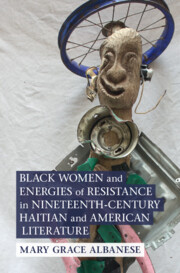Book contents
- Black Women and Energies of Resistance in Nineteenth-Century Haitian and American Literature
- Cambridge Studies in American Literature and Culture
- Black Women and Energies of Resistance in Nineteenth-Century Haitian and American Literature
- Copyright page
- Contents
- Figures
- Acknowledgments
- Introduction
- Chapter 1 Powering the Soul
- Chapter 2 Marie Laveau’s Generational Arts
- Chapter 3 Freedom’s Conduit
- Chapter 4 “A Wandering Maniac”
- Chapter 5 Mesmeric Revolution
- Coda
- Bibliography
- Index
- Recent books in this series (continued from page )
Introduction
Modulating Modernity
Published online by Cambridge University Press: 09 November 2023
- Black Women and Energies of Resistance in Nineteenth-Century Haitian and American Literature
- Cambridge Studies in American Literature and Culture
- Black Women and Energies of Resistance in Nineteenth-Century Haitian and American Literature
- Copyright page
- Contents
- Figures
- Acknowledgments
- Introduction
- Chapter 1 Powering the Soul
- Chapter 2 Marie Laveau’s Generational Arts
- Chapter 3 Freedom’s Conduit
- Chapter 4 “A Wandering Maniac”
- Chapter 5 Mesmeric Revolution
- Coda
- Bibliography
- Index
- Recent books in this series (continued from page )
Summary
In July 2019, in the midst of a record-breaking heat wave, Brooklyn went dark. In 90-degree temperatures, over 55,000 customers in Canarsie, Flatlands, Mill Basin, Bergen Beach, and Georgetown lost electricity in one of the largest power outages in New York’s history. Con Edison, the city’s power company, admitted that it deliberately disconnected these neighborhoods in order to prevent a widespread loss of power that would affect wealthier, whiter areas of the city. Although Black neighborhoods earn the highest scores in New York City’s heat vulnerability index (a ranking system that takes into account the proportion of green space to developed space, access to air conditioning, and the percentage of people living below poverty levels), they are the first on the line when the city’s infrastructure fails.1 What the index does not take into account, however, are the social and political risks to which these neighborhoods are also exposed during a blackout. After the lights went out, 200 police officers flooded Brooklyn, with the nebulous mandate to preserve order. A week earlier, the US Department of Justice had announced that it would not press charges against Daniel Pantaleo, the white police officer who killed Eric Garner on Staten Island in 2014. Now law enforcement roamed the streets of Canarsie, policing Black children for splashing water in 90-degree heat.
Keywords
- Type
- Chapter
- Information
- Black Women and Energies of Resistance in Nineteenth-Century Haitian and American Literature , pp. 1 - 15Publisher: Cambridge University PressPrint publication year: 2023

